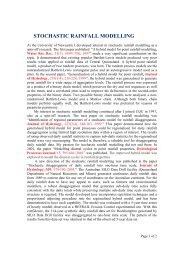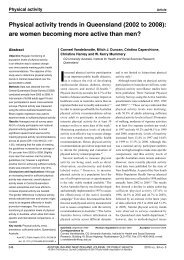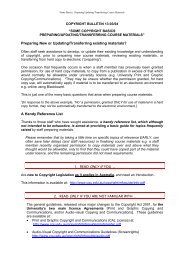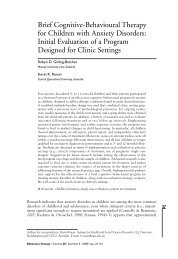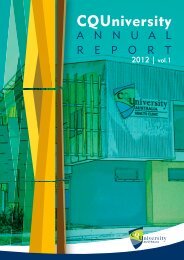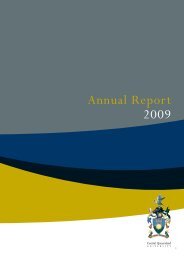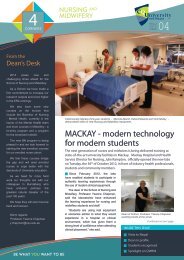2007 Annual Report - Central Queensland University
2007 Annual Report - Central Queensland University
2007 Annual Report - Central Queensland University
You also want an ePaper? Increase the reach of your titles
YUMPU automatically turns print PDFs into web optimized ePapers that Google loves.
<strong>2007</strong> Centre for Plant & Water Science <strong>Annual</strong> <strong>Report</strong>MICROFUNGI IN ROCKHAMPTON MUNICIPAL WATER SUPPLYVery little work has been carried out on the mycology of domestic water supplies. There are nolegislated standards for fungi in water and the few international reports that have beenpublished have all used different protocols, lengths of study periods and various water sources.This is a seminal study of the mycology of a sub-tropical city’s water supply post-treatment.Fungi are known to cause off-odours and smells and some are opportunistic human pathogens.A standard protocol has been devised using a standardised medium supplemented withstreptomycin onto which is placed a 0.45 µm filter through which a known amount of samplewater has been passed. This filter-medium combination is then incubated in the dark at 25°Cand colony counts made at regular times. Samples have been regularly taken from ninestandpipes and six storage reservoirs throughout the city over a period of about 15 months. Afurther four sampling sites are located at the local treatment plant. This plant draws water fromthe Fitzroy River which is then flocculated using poly-aluminium chloride, settled, sand filteredand then chlorinated to a level known to suppress bacterial growth.Microfungi have been found in all parts of the supply system with the exception of that sampletaken immediately post-chlorination. A large data bank has been assembled for each of the 19sites and this contains not only the mycobiological data but also data relating to the physicochemicalparameters of the sampling sites. In total, 63 genera of microfungi have beenrecovered from the distribution system and the 5 most commonly encountered, as a % ofsamples, are Cladosporium (52%), Penicillium (17%), Aspergillus (7%), Fusarium (3%) andTrichoderma (3%). These are common saprotrophic fungi usually associated with decayingvegetation. There is evidence that with increasing oxidation-reduction potential and with freeand total chlorine that the number of microfungi recovered falls. Increasing turbidity increasesthe number of microfungi recovered but an increase in temperature increases the bacterial andyeast counts but not that of filamentous fungi.Cultural and SEM studies on biofilm formation on PVC and concrete coupons placed in thewater supply have revealed a paucity of microbiological matter. This is thought to be due to theoligotrophic nature of the water supply. Thus, the source of microfungi is probably not frombiofilms due to lack of nutrients. Seminal studies on PAC flocs has shown that they remove notonly colloidal inorganic matter but also organic particles, bacteria, fungal propagules andhyphae, cyanoprokaryotes and other microscopic aquatic organisms.Microfungal contamination from the reservoirs has also been thoroughly checked by a varietyof means and there is very little, if any, microfungal growth within the reservoirs. Thus, thesource of these microfungi is thought to be from the air from which they are deposited into thetreatment plant intake water with subsequent contamination while in the reservoirs which arenot air-tight. Run-off water is also a likely source.The maximum level of chlorination which meets national guidelines with regards bacterialsuppression is 0.6 mg/L. It is now thought that filamentous fungi are damaged but not killed bythe chlorine and that they can repair chlorine damage. Intensive lab-based studies are nowexamining the effect of chlorine levels and exposure times on fungal spore survival.PROJECT STAFF Principal Investigators:Supervisor:Noel SammonDr Keith HarrowerFUNDINGRockhampton City Council<strong>Central</strong> <strong>Queensland</strong> <strong>University</strong>49





